Problem Solving with ICT (ICT10001)
VerifiedAdded on 2021/11/19
|13
|3186
|54
AI Summary
Contribute Materials
Your contribution can guide someone’s learning journey. Share your
documents today.
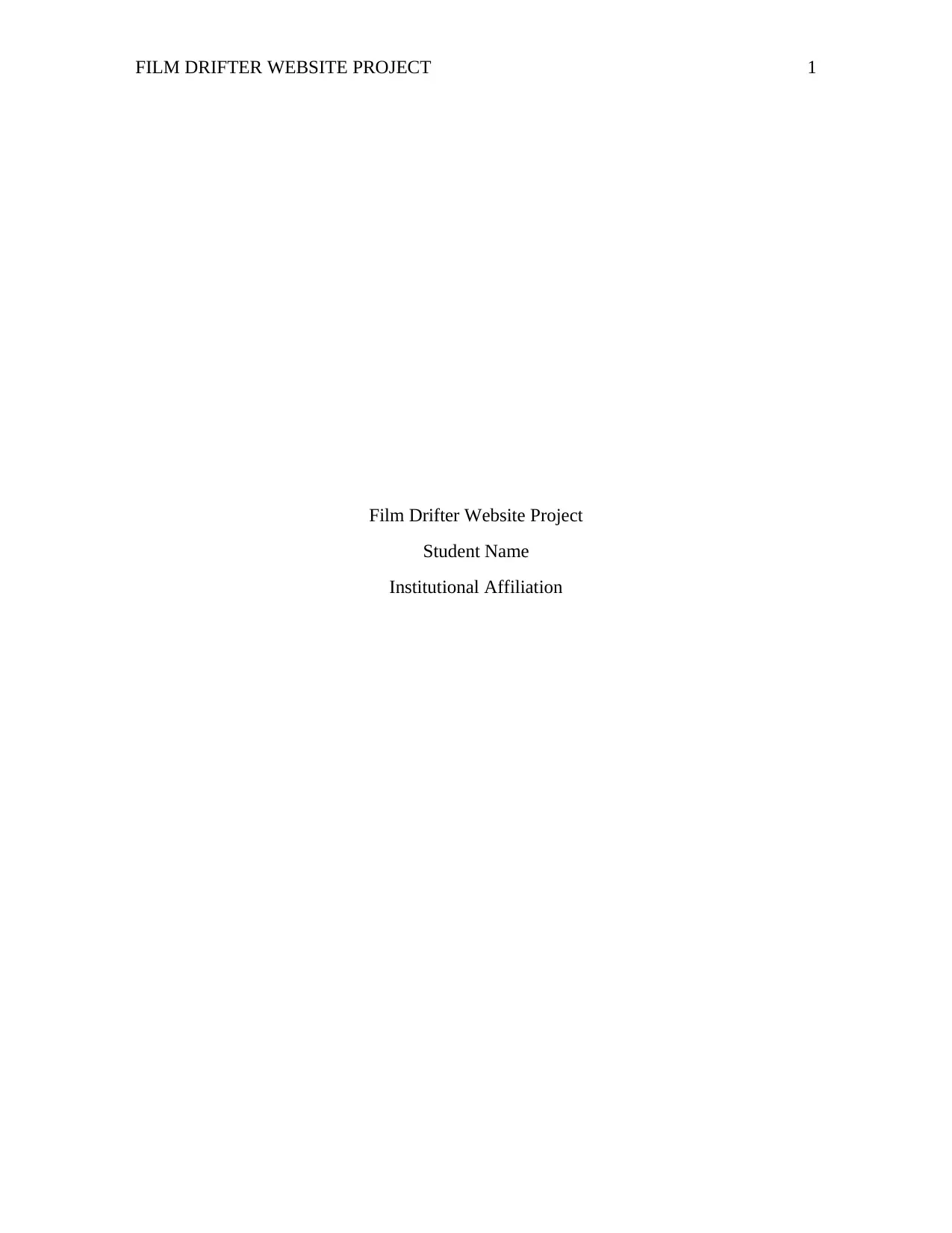
FILM DRIFTER WEBSITE PROJECT 1
Film Drifter Website Project
Student Name
Institutional Affiliation
Film Drifter Website Project
Student Name
Institutional Affiliation
Secure Best Marks with AI Grader
Need help grading? Try our AI Grader for instant feedback on your assignments.
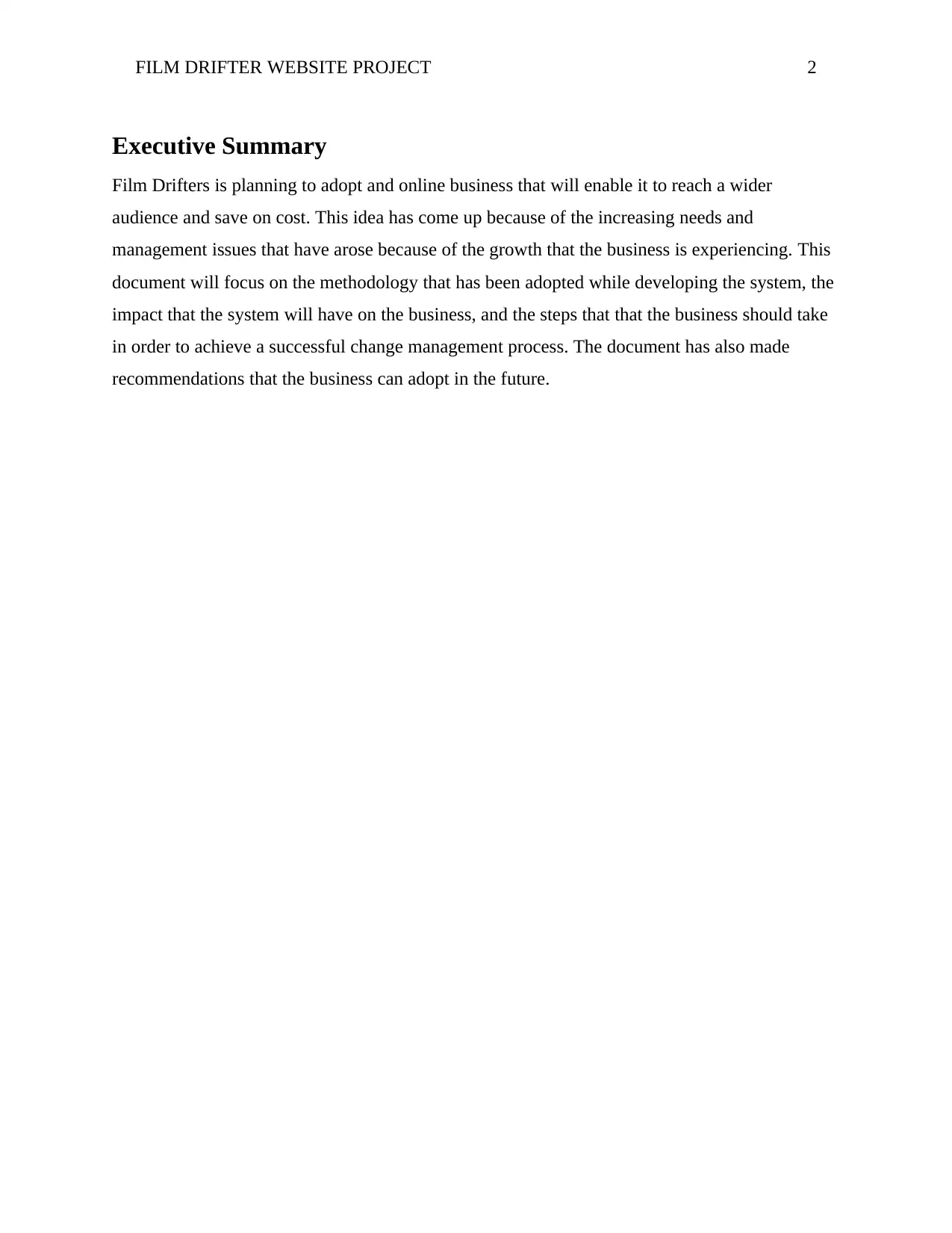
FILM DRIFTER WEBSITE PROJECT 2
Executive Summary
Film Drifters is planning to adopt and online business that will enable it to reach a wider
audience and save on cost. This idea has come up because of the increasing needs and
management issues that have arose because of the growth that the business is experiencing. This
document will focus on the methodology that has been adopted while developing the system, the
impact that the system will have on the business, and the steps that that the business should take
in order to achieve a successful change management process. The document has also made
recommendations that the business can adopt in the future.
Executive Summary
Film Drifters is planning to adopt and online business that will enable it to reach a wider
audience and save on cost. This idea has come up because of the increasing needs and
management issues that have arose because of the growth that the business is experiencing. This
document will focus on the methodology that has been adopted while developing the system, the
impact that the system will have on the business, and the steps that that the business should take
in order to achieve a successful change management process. The document has also made
recommendations that the business can adopt in the future.
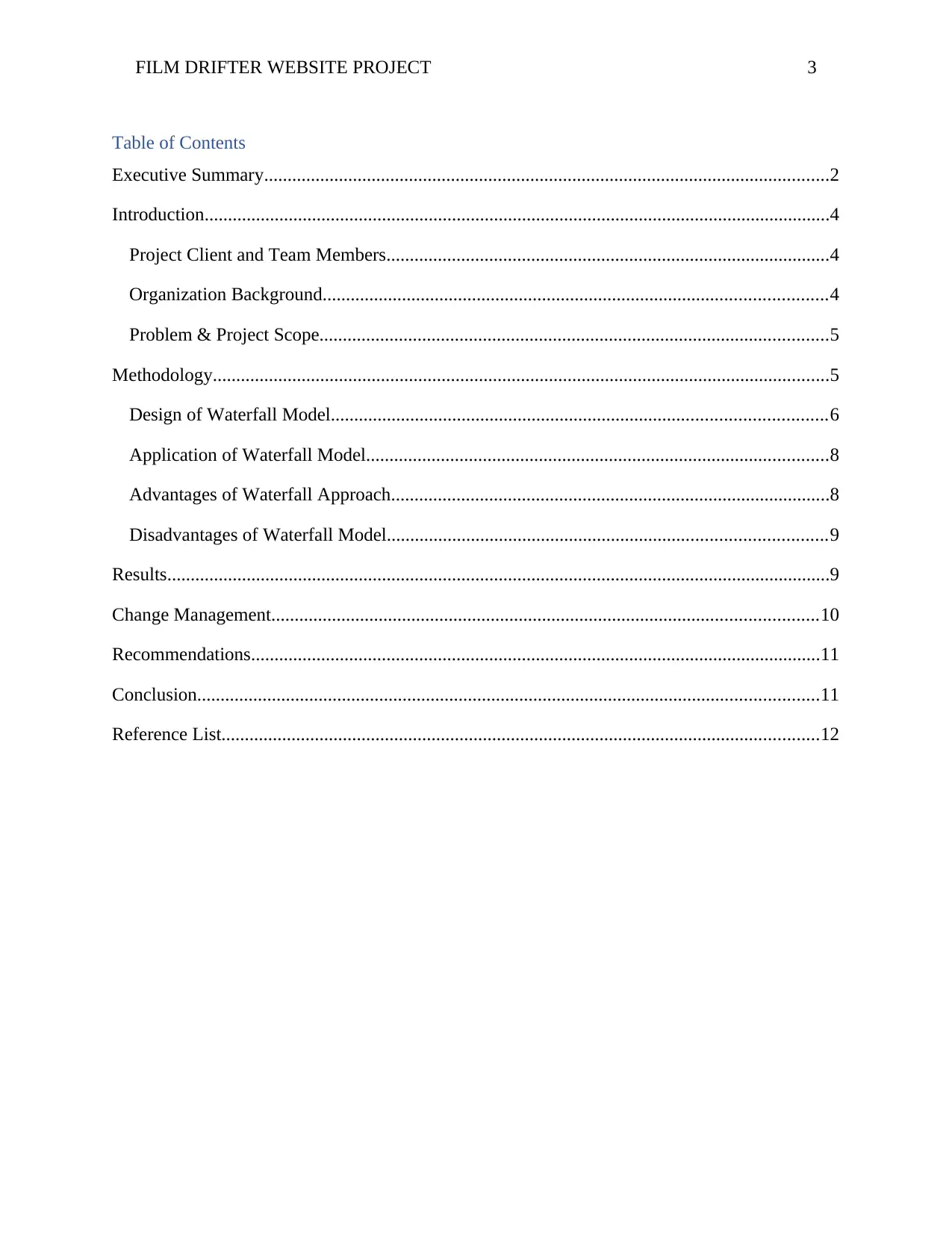
FILM DRIFTER WEBSITE PROJECT 3
Table of Contents
Executive Summary.........................................................................................................................2
Introduction......................................................................................................................................4
Project Client and Team Members...............................................................................................4
Organization Background............................................................................................................4
Problem & Project Scope.............................................................................................................5
Methodology....................................................................................................................................5
Design of Waterfall Model..........................................................................................................6
Application of Waterfall Model...................................................................................................8
Advantages of Waterfall Approach..............................................................................................8
Disadvantages of Waterfall Model..............................................................................................9
Results..............................................................................................................................................9
Change Management.....................................................................................................................10
Recommendations..........................................................................................................................11
Conclusion.....................................................................................................................................11
Reference List................................................................................................................................12
Table of Contents
Executive Summary.........................................................................................................................2
Introduction......................................................................................................................................4
Project Client and Team Members...............................................................................................4
Organization Background............................................................................................................4
Problem & Project Scope.............................................................................................................5
Methodology....................................................................................................................................5
Design of Waterfall Model..........................................................................................................6
Application of Waterfall Model...................................................................................................8
Advantages of Waterfall Approach..............................................................................................8
Disadvantages of Waterfall Model..............................................................................................9
Results..............................................................................................................................................9
Change Management.....................................................................................................................10
Recommendations..........................................................................................................................11
Conclusion.....................................................................................................................................11
Reference List................................................................................................................................12
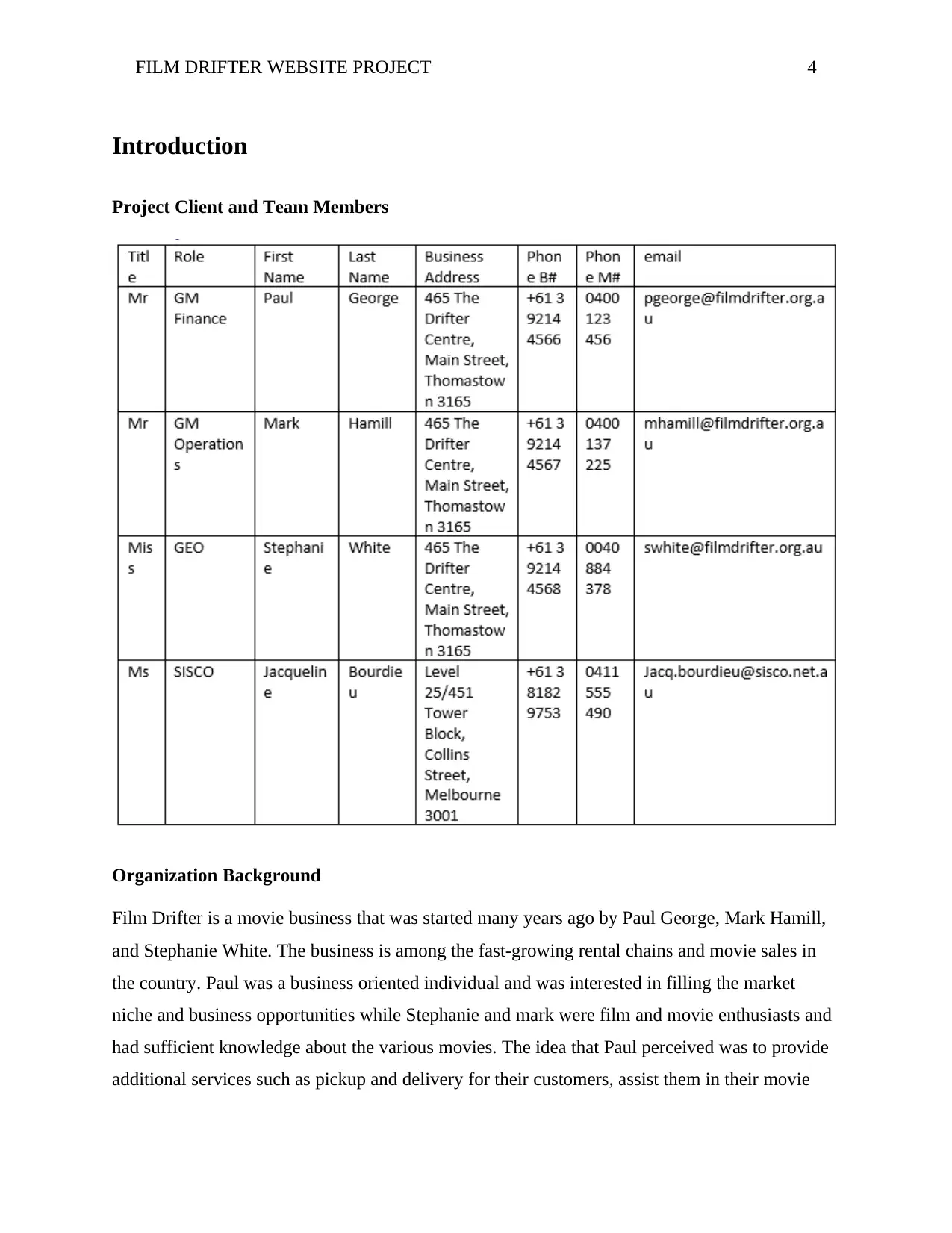
FILM DRIFTER WEBSITE PROJECT 4
Introduction
Project Client and Team Members
Organization Background
Film Drifter is a movie business that was started many years ago by Paul George, Mark Hamill,
and Stephanie White. The business is among the fast-growing rental chains and movie sales in
the country. Paul was a business oriented individual and was interested in filling the market
niche and business opportunities while Stephanie and mark were film and movie enthusiasts and
had sufficient knowledge about the various movies. The idea that Paul perceived was to provide
additional services such as pickup and delivery for their customers, assist them in their movie
Introduction
Project Client and Team Members
Organization Background
Film Drifter is a movie business that was started many years ago by Paul George, Mark Hamill,
and Stephanie White. The business is among the fast-growing rental chains and movie sales in
the country. Paul was a business oriented individual and was interested in filling the market
niche and business opportunities while Stephanie and mark were film and movie enthusiasts and
had sufficient knowledge about the various movies. The idea that Paul perceived was to provide
additional services such as pickup and delivery for their customers, assist them in their movie
Secure Best Marks with AI Grader
Need help grading? Try our AI Grader for instant feedback on your assignments.
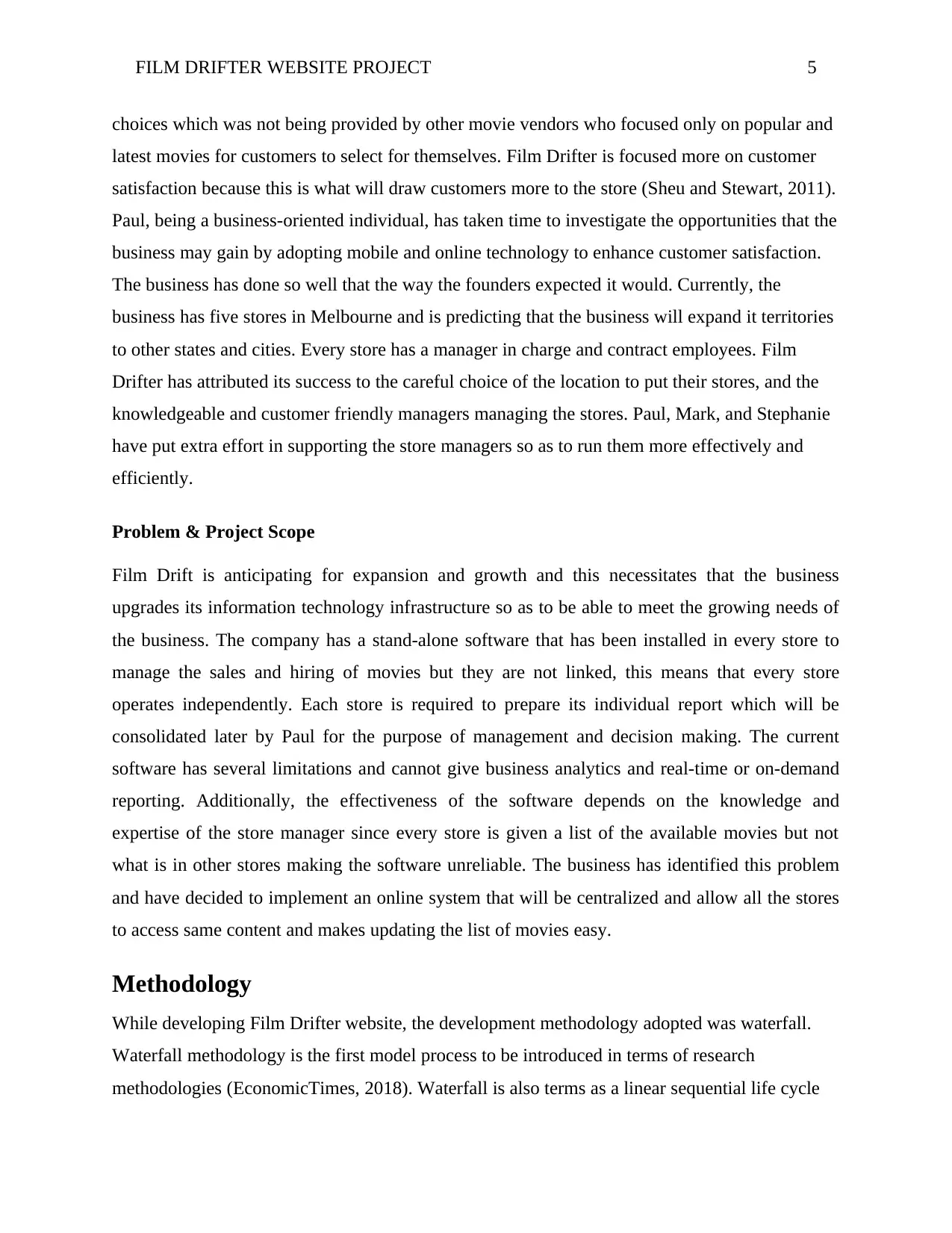
FILM DRIFTER WEBSITE PROJECT 5
choices which was not being provided by other movie vendors who focused only on popular and
latest movies for customers to select for themselves. Film Drifter is focused more on customer
satisfaction because this is what will draw customers more to the store (Sheu and Stewart, 2011).
Paul, being a business-oriented individual, has taken time to investigate the opportunities that the
business may gain by adopting mobile and online technology to enhance customer satisfaction.
The business has done so well that the way the founders expected it would. Currently, the
business has five stores in Melbourne and is predicting that the business will expand it territories
to other states and cities. Every store has a manager in charge and contract employees. Film
Drifter has attributed its success to the careful choice of the location to put their stores, and the
knowledgeable and customer friendly managers managing the stores. Paul, Mark, and Stephanie
have put extra effort in supporting the store managers so as to run them more effectively and
efficiently.
Problem & Project Scope
Film Drift is anticipating for expansion and growth and this necessitates that the business
upgrades its information technology infrastructure so as to be able to meet the growing needs of
the business. The company has a stand-alone software that has been installed in every store to
manage the sales and hiring of movies but they are not linked, this means that every store
operates independently. Each store is required to prepare its individual report which will be
consolidated later by Paul for the purpose of management and decision making. The current
software has several limitations and cannot give business analytics and real-time or on-demand
reporting. Additionally, the effectiveness of the software depends on the knowledge and
expertise of the store manager since every store is given a list of the available movies but not
what is in other stores making the software unreliable. The business has identified this problem
and have decided to implement an online system that will be centralized and allow all the stores
to access same content and makes updating the list of movies easy.
Methodology
While developing Film Drifter website, the development methodology adopted was waterfall.
Waterfall methodology is the first model process to be introduced in terms of research
methodologies (EconomicTimes, 2018). Waterfall is also terms as a linear sequential life cycle
choices which was not being provided by other movie vendors who focused only on popular and
latest movies for customers to select for themselves. Film Drifter is focused more on customer
satisfaction because this is what will draw customers more to the store (Sheu and Stewart, 2011).
Paul, being a business-oriented individual, has taken time to investigate the opportunities that the
business may gain by adopting mobile and online technology to enhance customer satisfaction.
The business has done so well that the way the founders expected it would. Currently, the
business has five stores in Melbourne and is predicting that the business will expand it territories
to other states and cities. Every store has a manager in charge and contract employees. Film
Drifter has attributed its success to the careful choice of the location to put their stores, and the
knowledgeable and customer friendly managers managing the stores. Paul, Mark, and Stephanie
have put extra effort in supporting the store managers so as to run them more effectively and
efficiently.
Problem & Project Scope
Film Drift is anticipating for expansion and growth and this necessitates that the business
upgrades its information technology infrastructure so as to be able to meet the growing needs of
the business. The company has a stand-alone software that has been installed in every store to
manage the sales and hiring of movies but they are not linked, this means that every store
operates independently. Each store is required to prepare its individual report which will be
consolidated later by Paul for the purpose of management and decision making. The current
software has several limitations and cannot give business analytics and real-time or on-demand
reporting. Additionally, the effectiveness of the software depends on the knowledge and
expertise of the store manager since every store is given a list of the available movies but not
what is in other stores making the software unreliable. The business has identified this problem
and have decided to implement an online system that will be centralized and allow all the stores
to access same content and makes updating the list of movies easy.
Methodology
While developing Film Drifter website, the development methodology adopted was waterfall.
Waterfall methodology is the first model process to be introduced in terms of research
methodologies (EconomicTimes, 2018). Waterfall is also terms as a linear sequential life cycle
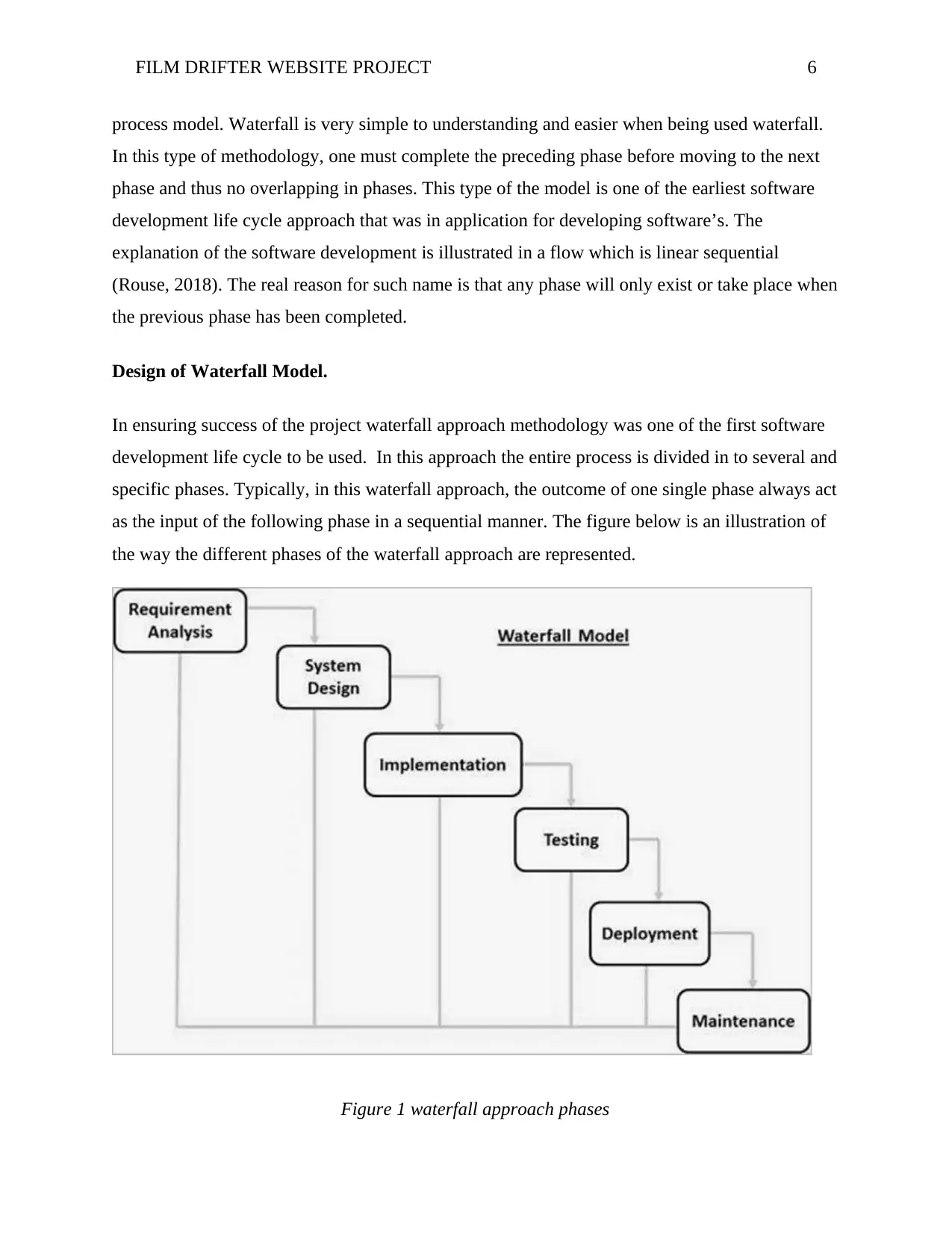
FILM DRIFTER WEBSITE PROJECT 6
process model. Waterfall is very simple to understanding and easier when being used waterfall.
In this type of methodology, one must complete the preceding phase before moving to the next
phase and thus no overlapping in phases. This type of the model is one of the earliest software
development life cycle approach that was in application for developing software’s. The
explanation of the software development is illustrated in a flow which is linear sequential
(Rouse, 2018). The real reason for such name is that any phase will only exist or take place when
the previous phase has been completed.
Design of Waterfall Model.
In ensuring success of the project waterfall approach methodology was one of the first software
development life cycle to be used. In this approach the entire process is divided in to several and
specific phases. Typically, in this waterfall approach, the outcome of one single phase always act
as the input of the following phase in a sequential manner. The figure below is an illustration of
the way the different phases of the waterfall approach are represented.
Figure 1 waterfall approach phases
process model. Waterfall is very simple to understanding and easier when being used waterfall.
In this type of methodology, one must complete the preceding phase before moving to the next
phase and thus no overlapping in phases. This type of the model is one of the earliest software
development life cycle approach that was in application for developing software’s. The
explanation of the software development is illustrated in a flow which is linear sequential
(Rouse, 2018). The real reason for such name is that any phase will only exist or take place when
the previous phase has been completed.
Design of Waterfall Model.
In ensuring success of the project waterfall approach methodology was one of the first software
development life cycle to be used. In this approach the entire process is divided in to several and
specific phases. Typically, in this waterfall approach, the outcome of one single phase always act
as the input of the following phase in a sequential manner. The figure below is an illustration of
the way the different phases of the waterfall approach are represented.
Figure 1 waterfall approach phases
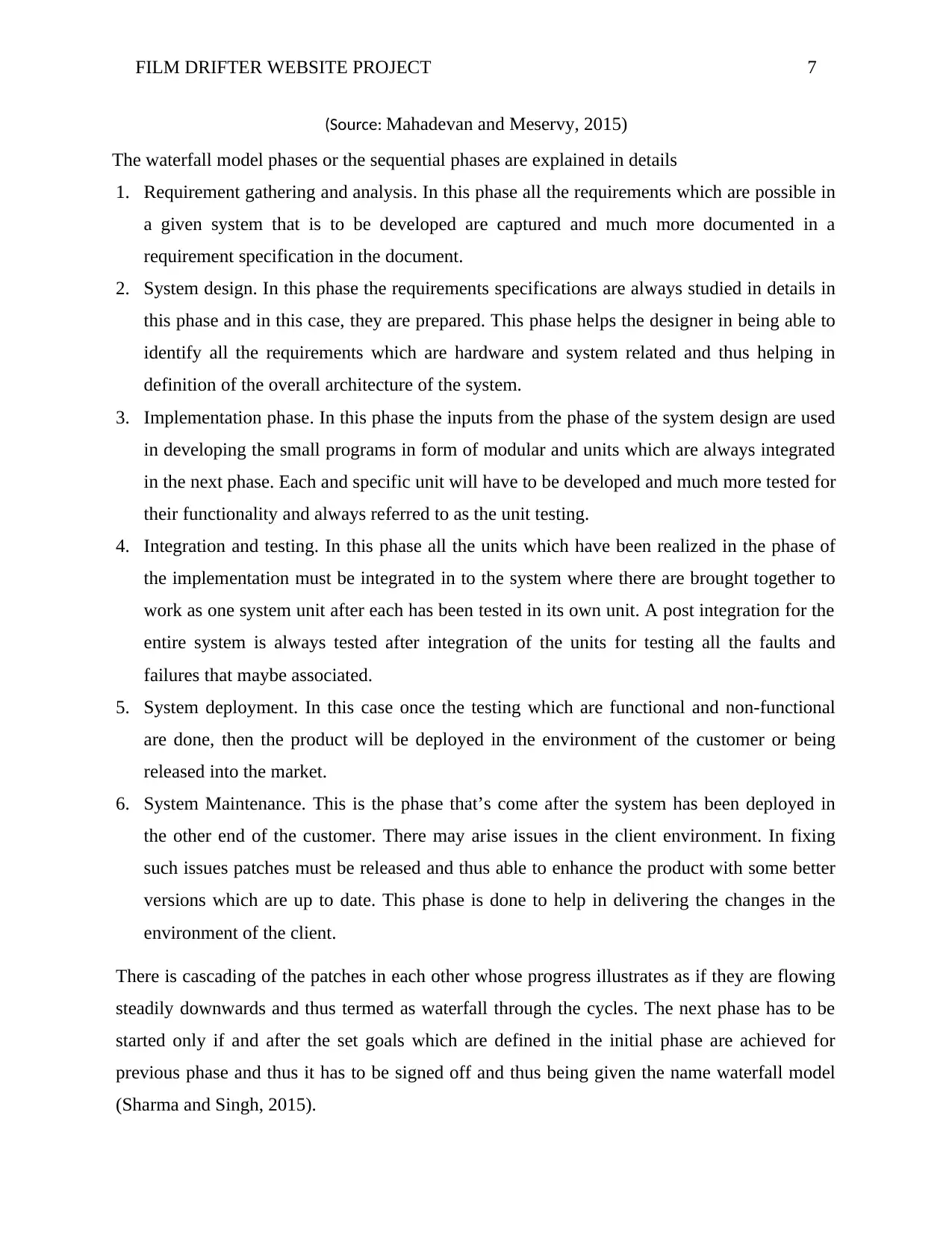
FILM DRIFTER WEBSITE PROJECT 7
(Source: Mahadevan and Meservy, 2015)
The waterfall model phases or the sequential phases are explained in details
1. Requirement gathering and analysis. In this phase all the requirements which are possible in
a given system that is to be developed are captured and much more documented in a
requirement specification in the document.
2. System design. In this phase the requirements specifications are always studied in details in
this phase and in this case, they are prepared. This phase helps the designer in being able to
identify all the requirements which are hardware and system related and thus helping in
definition of the overall architecture of the system.
3. Implementation phase. In this phase the inputs from the phase of the system design are used
in developing the small programs in form of modular and units which are always integrated
in the next phase. Each and specific unit will have to be developed and much more tested for
their functionality and always referred to as the unit testing.
4. Integration and testing. In this phase all the units which have been realized in the phase of
the implementation must be integrated in to the system where there are brought together to
work as one system unit after each has been tested in its own unit. A post integration for the
entire system is always tested after integration of the units for testing all the faults and
failures that maybe associated.
5. System deployment. In this case once the testing which are functional and non-functional
are done, then the product will be deployed in the environment of the customer or being
released into the market.
6. System Maintenance. This is the phase that’s come after the system has been deployed in
the other end of the customer. There may arise issues in the client environment. In fixing
such issues patches must be released and thus able to enhance the product with some better
versions which are up to date. This phase is done to help in delivering the changes in the
environment of the client.
There is cascading of the patches in each other whose progress illustrates as if they are flowing
steadily downwards and thus termed as waterfall through the cycles. The next phase has to be
started only if and after the set goals which are defined in the initial phase are achieved for
previous phase and thus it has to be signed off and thus being given the name waterfall model
(Sharma and Singh, 2015).
(Source: Mahadevan and Meservy, 2015)
The waterfall model phases or the sequential phases are explained in details
1. Requirement gathering and analysis. In this phase all the requirements which are possible in
a given system that is to be developed are captured and much more documented in a
requirement specification in the document.
2. System design. In this phase the requirements specifications are always studied in details in
this phase and in this case, they are prepared. This phase helps the designer in being able to
identify all the requirements which are hardware and system related and thus helping in
definition of the overall architecture of the system.
3. Implementation phase. In this phase the inputs from the phase of the system design are used
in developing the small programs in form of modular and units which are always integrated
in the next phase. Each and specific unit will have to be developed and much more tested for
their functionality and always referred to as the unit testing.
4. Integration and testing. In this phase all the units which have been realized in the phase of
the implementation must be integrated in to the system where there are brought together to
work as one system unit after each has been tested in its own unit. A post integration for the
entire system is always tested after integration of the units for testing all the faults and
failures that maybe associated.
5. System deployment. In this case once the testing which are functional and non-functional
are done, then the product will be deployed in the environment of the customer or being
released into the market.
6. System Maintenance. This is the phase that’s come after the system has been deployed in
the other end of the customer. There may arise issues in the client environment. In fixing
such issues patches must be released and thus able to enhance the product with some better
versions which are up to date. This phase is done to help in delivering the changes in the
environment of the client.
There is cascading of the patches in each other whose progress illustrates as if they are flowing
steadily downwards and thus termed as waterfall through the cycles. The next phase has to be
started only if and after the set goals which are defined in the initial phase are achieved for
previous phase and thus it has to be signed off and thus being given the name waterfall model
(Sharma and Singh, 2015).
Paraphrase This Document
Need a fresh take? Get an instant paraphrase of this document with our AI Paraphraser
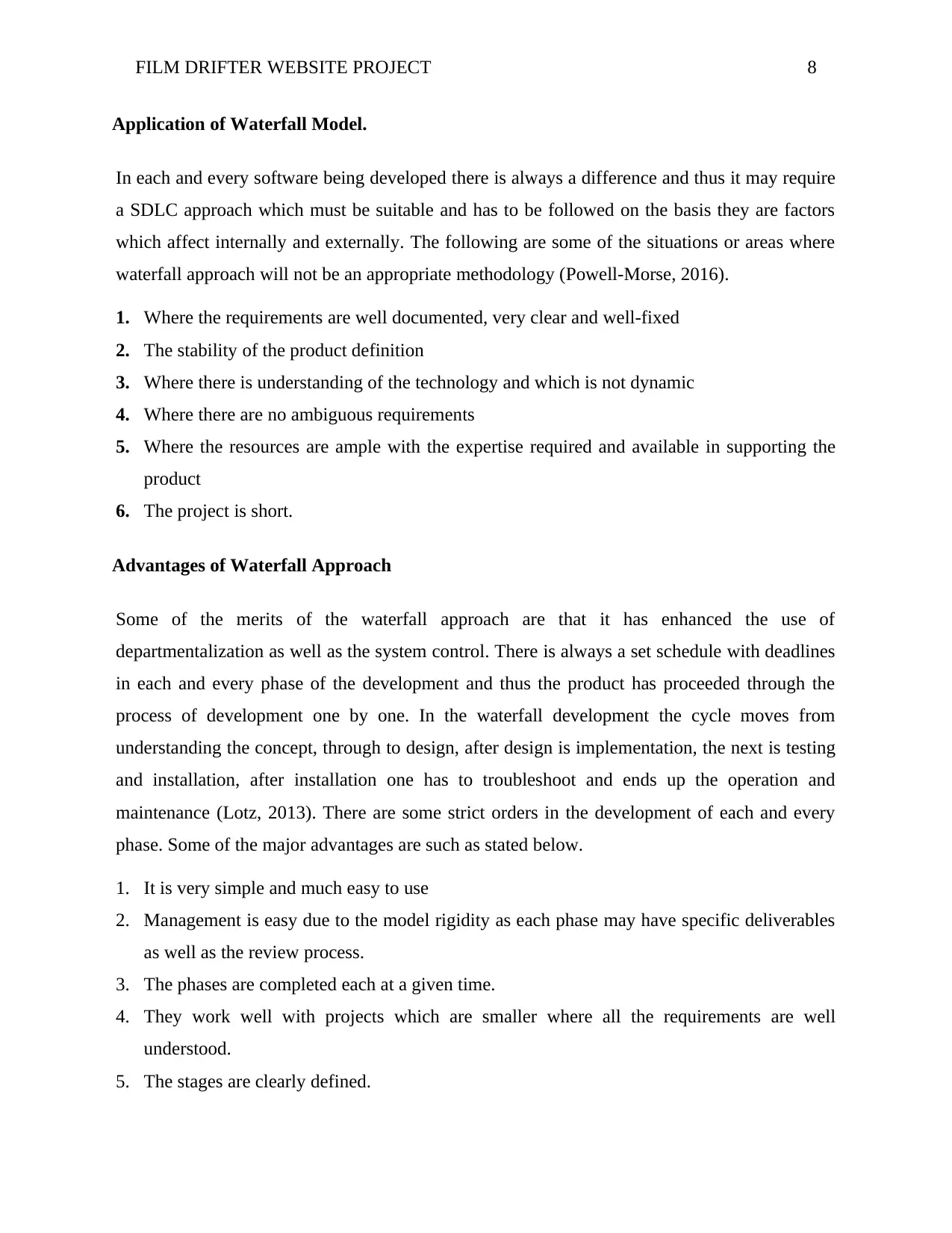
FILM DRIFTER WEBSITE PROJECT 8
Application of Waterfall Model.
In each and every software being developed there is always a difference and thus it may require
a SDLC approach which must be suitable and has to be followed on the basis they are factors
which affect internally and externally. The following are some of the situations or areas where
waterfall approach will not be an appropriate methodology (Powell-Morse, 2016).
1. Where the requirements are well documented, very clear and well-fixed
2. The stability of the product definition
3. Where there is understanding of the technology and which is not dynamic
4. Where there are no ambiguous requirements
5. Where the resources are ample with the expertise required and available in supporting the
product
6. The project is short.
Advantages of Waterfall Approach
Some of the merits of the waterfall approach are that it has enhanced the use of
departmentalization as well as the system control. There is always a set schedule with deadlines
in each and every phase of the development and thus the product has proceeded through the
process of development one by one. In the waterfall development the cycle moves from
understanding the concept, through to design, after design is implementation, the next is testing
and installation, after installation one has to troubleshoot and ends up the operation and
maintenance (Lotz, 2013). There are some strict orders in the development of each and every
phase. Some of the major advantages are such as stated below.
1. It is very simple and much easy to use
2. Management is easy due to the model rigidity as each phase may have specific deliverables
as well as the review process.
3. The phases are completed each at a given time.
4. They work well with projects which are smaller where all the requirements are well
understood.
5. The stages are clearly defined.
Application of Waterfall Model.
In each and every software being developed there is always a difference and thus it may require
a SDLC approach which must be suitable and has to be followed on the basis they are factors
which affect internally and externally. The following are some of the situations or areas where
waterfall approach will not be an appropriate methodology (Powell-Morse, 2016).
1. Where the requirements are well documented, very clear and well-fixed
2. The stability of the product definition
3. Where there is understanding of the technology and which is not dynamic
4. Where there are no ambiguous requirements
5. Where the resources are ample with the expertise required and available in supporting the
product
6. The project is short.
Advantages of Waterfall Approach
Some of the merits of the waterfall approach are that it has enhanced the use of
departmentalization as well as the system control. There is always a set schedule with deadlines
in each and every phase of the development and thus the product has proceeded through the
process of development one by one. In the waterfall development the cycle moves from
understanding the concept, through to design, after design is implementation, the next is testing
and installation, after installation one has to troubleshoot and ends up the operation and
maintenance (Lotz, 2013). There are some strict orders in the development of each and every
phase. Some of the major advantages are such as stated below.
1. It is very simple and much easy to use
2. Management is easy due to the model rigidity as each phase may have specific deliverables
as well as the review process.
3. The phases are completed each at a given time.
4. They work well with projects which are smaller where all the requirements are well
understood.
5. The stages are clearly defined.
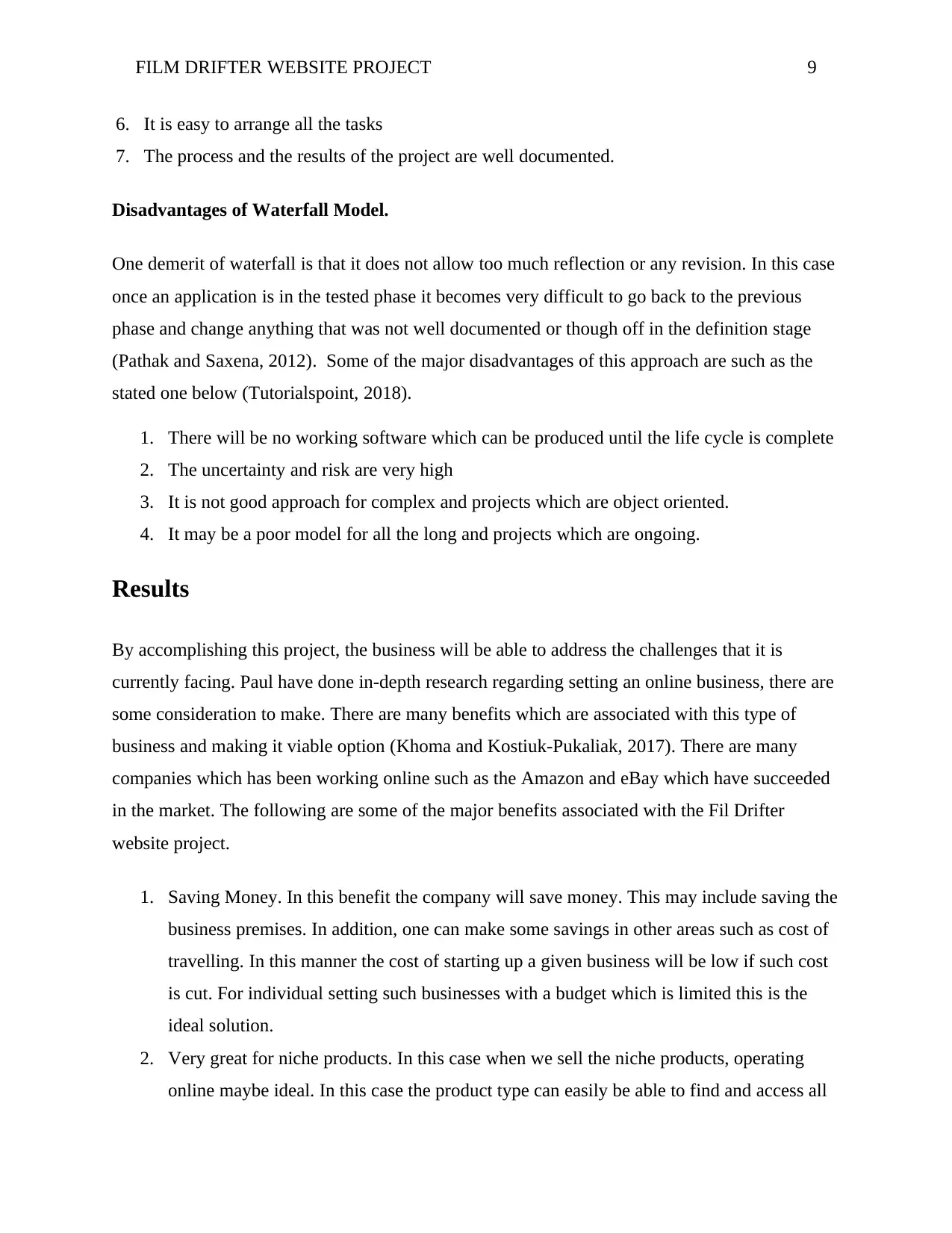
FILM DRIFTER WEBSITE PROJECT 9
6. It is easy to arrange all the tasks
7. The process and the results of the project are well documented.
Disadvantages of Waterfall Model.
One demerit of waterfall is that it does not allow too much reflection or any revision. In this case
once an application is in the tested phase it becomes very difficult to go back to the previous
phase and change anything that was not well documented or though off in the definition stage
(Pathak and Saxena, 2012). Some of the major disadvantages of this approach are such as the
stated one below (Tutorialspoint, 2018).
1. There will be no working software which can be produced until the life cycle is complete
2. The uncertainty and risk are very high
3. It is not good approach for complex and projects which are object oriented.
4. It may be a poor model for all the long and projects which are ongoing.
Results
By accomplishing this project, the business will be able to address the challenges that it is
currently facing. Paul have done in-depth research regarding setting an online business, there are
some consideration to make. There are many benefits which are associated with this type of
business and making it viable option (Khoma and Kostiuk-Pukaliak, 2017). There are many
companies which has been working online such as the Amazon and eBay which have succeeded
in the market. The following are some of the major benefits associated with the Fil Drifter
website project.
1. Saving Money. In this benefit the company will save money. This may include saving the
business premises. In addition, one can make some savings in other areas such as cost of
travelling. In this manner the cost of starting up a given business will be low if such cost
is cut. For individual setting such businesses with a budget which is limited this is the
ideal solution.
2. Very great for niche products. In this case when we sell the niche products, operating
online maybe ideal. In this case the product type can easily be able to find and access all
6. It is easy to arrange all the tasks
7. The process and the results of the project are well documented.
Disadvantages of Waterfall Model.
One demerit of waterfall is that it does not allow too much reflection or any revision. In this case
once an application is in the tested phase it becomes very difficult to go back to the previous
phase and change anything that was not well documented or though off in the definition stage
(Pathak and Saxena, 2012). Some of the major disadvantages of this approach are such as the
stated one below (Tutorialspoint, 2018).
1. There will be no working software which can be produced until the life cycle is complete
2. The uncertainty and risk are very high
3. It is not good approach for complex and projects which are object oriented.
4. It may be a poor model for all the long and projects which are ongoing.
Results
By accomplishing this project, the business will be able to address the challenges that it is
currently facing. Paul have done in-depth research regarding setting an online business, there are
some consideration to make. There are many benefits which are associated with this type of
business and making it viable option (Khoma and Kostiuk-Pukaliak, 2017). There are many
companies which has been working online such as the Amazon and eBay which have succeeded
in the market. The following are some of the major benefits associated with the Fil Drifter
website project.
1. Saving Money. In this benefit the company will save money. This may include saving the
business premises. In addition, one can make some savings in other areas such as cost of
travelling. In this manner the cost of starting up a given business will be low if such cost
is cut. For individual setting such businesses with a budget which is limited this is the
ideal solution.
2. Very great for niche products. In this case when we sell the niche products, operating
online maybe ideal. In this case the product type can easily be able to find and access all
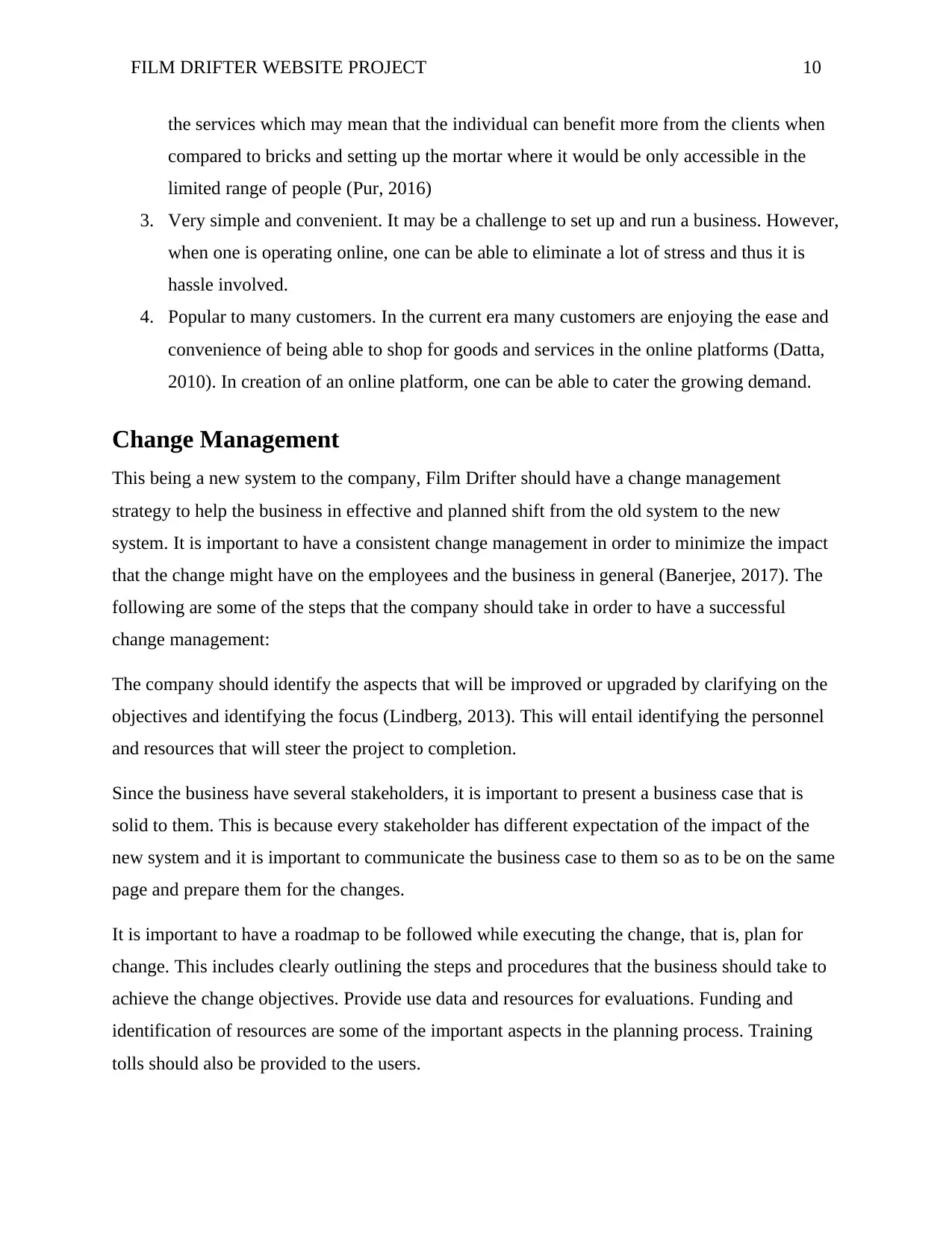
FILM DRIFTER WEBSITE PROJECT 10
the services which may mean that the individual can benefit more from the clients when
compared to bricks and setting up the mortar where it would be only accessible in the
limited range of people (Pur, 2016)
3. Very simple and convenient. It may be a challenge to set up and run a business. However,
when one is operating online, one can be able to eliminate a lot of stress and thus it is
hassle involved.
4. Popular to many customers. In the current era many customers are enjoying the ease and
convenience of being able to shop for goods and services in the online platforms (Datta,
2010). In creation of an online platform, one can be able to cater the growing demand.
Change Management
This being a new system to the company, Film Drifter should have a change management
strategy to help the business in effective and planned shift from the old system to the new
system. It is important to have a consistent change management in order to minimize the impact
that the change might have on the employees and the business in general (Banerjee, 2017). The
following are some of the steps that the company should take in order to have a successful
change management:
The company should identify the aspects that will be improved or upgraded by clarifying on the
objectives and identifying the focus (Lindberg, 2013). This will entail identifying the personnel
and resources that will steer the project to completion.
Since the business have several stakeholders, it is important to present a business case that is
solid to them. This is because every stakeholder has different expectation of the impact of the
new system and it is important to communicate the business case to them so as to be on the same
page and prepare them for the changes.
It is important to have a roadmap to be followed while executing the change, that is, plan for
change. This includes clearly outlining the steps and procedures that the business should take to
achieve the change objectives. Provide use data and resources for evaluations. Funding and
identification of resources are some of the important aspects in the planning process. Training
tolls should also be provided to the users.
the services which may mean that the individual can benefit more from the clients when
compared to bricks and setting up the mortar where it would be only accessible in the
limited range of people (Pur, 2016)
3. Very simple and convenient. It may be a challenge to set up and run a business. However,
when one is operating online, one can be able to eliminate a lot of stress and thus it is
hassle involved.
4. Popular to many customers. In the current era many customers are enjoying the ease and
convenience of being able to shop for goods and services in the online platforms (Datta,
2010). In creation of an online platform, one can be able to cater the growing demand.
Change Management
This being a new system to the company, Film Drifter should have a change management
strategy to help the business in effective and planned shift from the old system to the new
system. It is important to have a consistent change management in order to minimize the impact
that the change might have on the employees and the business in general (Banerjee, 2017). The
following are some of the steps that the company should take in order to have a successful
change management:
The company should identify the aspects that will be improved or upgraded by clarifying on the
objectives and identifying the focus (Lindberg, 2013). This will entail identifying the personnel
and resources that will steer the project to completion.
Since the business have several stakeholders, it is important to present a business case that is
solid to them. This is because every stakeholder has different expectation of the impact of the
new system and it is important to communicate the business case to them so as to be on the same
page and prepare them for the changes.
It is important to have a roadmap to be followed while executing the change, that is, plan for
change. This includes clearly outlining the steps and procedures that the business should take to
achieve the change objectives. Provide use data and resources for evaluations. Funding and
identification of resources are some of the important aspects in the planning process. Training
tolls should also be provided to the users.
Secure Best Marks with AI Grader
Need help grading? Try our AI Grader for instant feedback on your assignments.
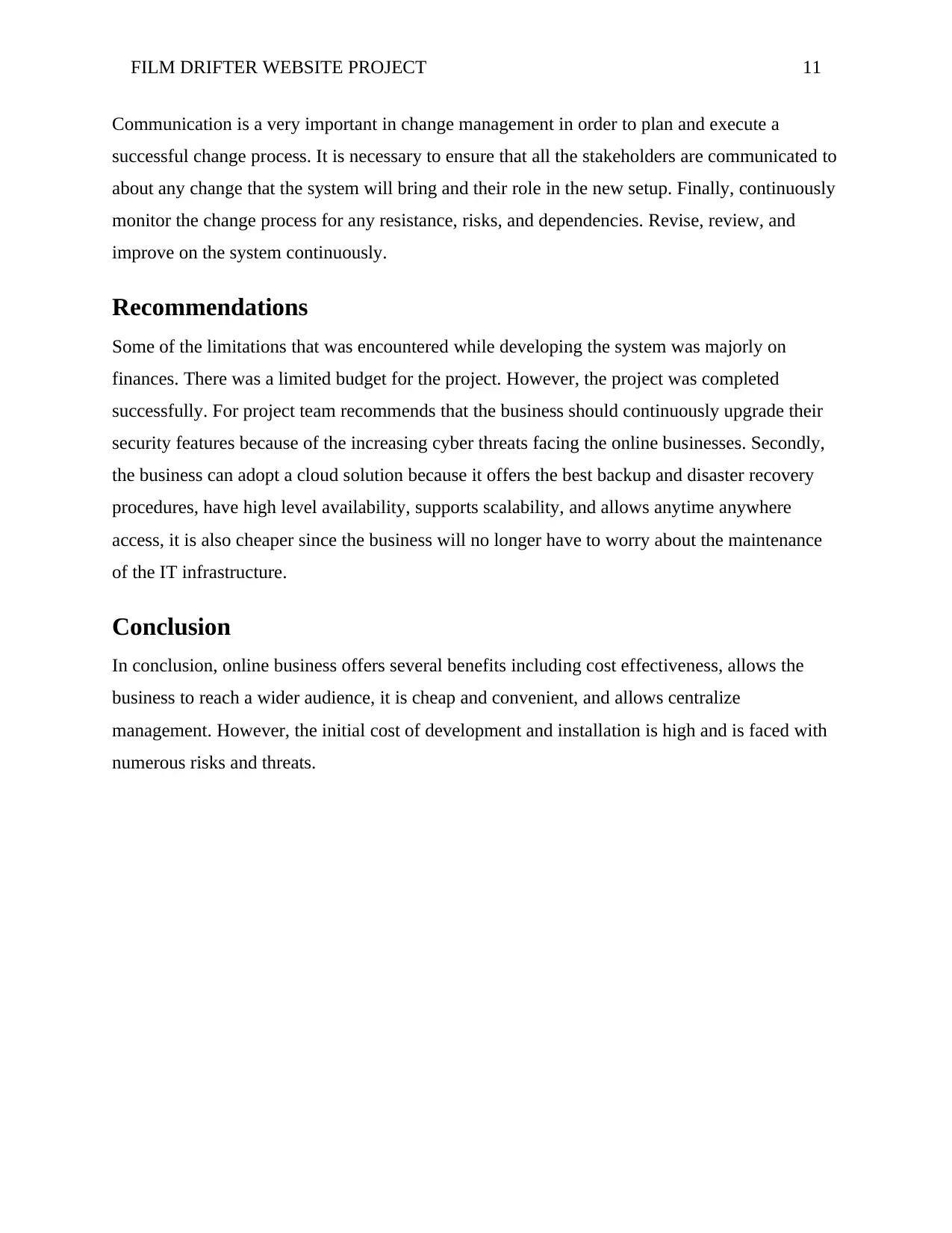
FILM DRIFTER WEBSITE PROJECT 11
Communication is a very important in change management in order to plan and execute a
successful change process. It is necessary to ensure that all the stakeholders are communicated to
about any change that the system will bring and their role in the new setup. Finally, continuously
monitor the change process for any resistance, risks, and dependencies. Revise, review, and
improve on the system continuously.
Recommendations
Some of the limitations that was encountered while developing the system was majorly on
finances. There was a limited budget for the project. However, the project was completed
successfully. For project team recommends that the business should continuously upgrade their
security features because of the increasing cyber threats facing the online businesses. Secondly,
the business can adopt a cloud solution because it offers the best backup and disaster recovery
procedures, have high level availability, supports scalability, and allows anytime anywhere
access, it is also cheaper since the business will no longer have to worry about the maintenance
of the IT infrastructure.
Conclusion
In conclusion, online business offers several benefits including cost effectiveness, allows the
business to reach a wider audience, it is cheap and convenient, and allows centralize
management. However, the initial cost of development and installation is high and is faced with
numerous risks and threats.
Communication is a very important in change management in order to plan and execute a
successful change process. It is necessary to ensure that all the stakeholders are communicated to
about any change that the system will bring and their role in the new setup. Finally, continuously
monitor the change process for any resistance, risks, and dependencies. Revise, review, and
improve on the system continuously.
Recommendations
Some of the limitations that was encountered while developing the system was majorly on
finances. There was a limited budget for the project. However, the project was completed
successfully. For project team recommends that the business should continuously upgrade their
security features because of the increasing cyber threats facing the online businesses. Secondly,
the business can adopt a cloud solution because it offers the best backup and disaster recovery
procedures, have high level availability, supports scalability, and allows anytime anywhere
access, it is also cheaper since the business will no longer have to worry about the maintenance
of the IT infrastructure.
Conclusion
In conclusion, online business offers several benefits including cost effectiveness, allows the
business to reach a wider audience, it is cheap and convenient, and allows centralize
management. However, the initial cost of development and installation is high and is faced with
numerous risks and threats.
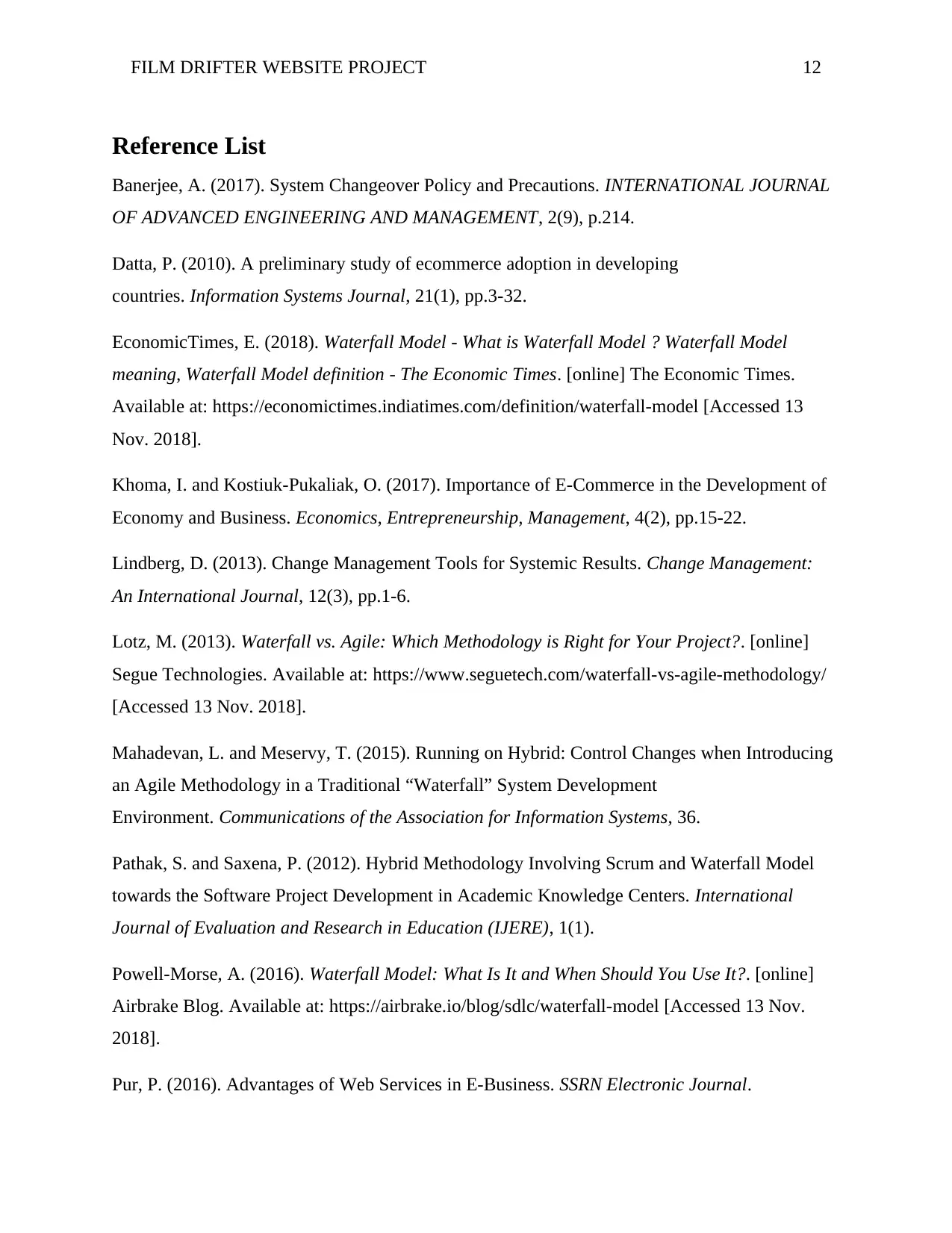
FILM DRIFTER WEBSITE PROJECT 12
Reference List
Banerjee, A. (2017). System Changeover Policy and Precautions. INTERNATIONAL JOURNAL
OF ADVANCED ENGINEERING AND MANAGEMENT, 2(9), p.214.
Datta, P. (2010). A preliminary study of ecommerce adoption in developing
countries. Information Systems Journal, 21(1), pp.3-32.
EconomicTimes, E. (2018). Waterfall Model - What is Waterfall Model ? Waterfall Model
meaning, Waterfall Model definition - The Economic Times. [online] The Economic Times.
Available at: https://economictimes.indiatimes.com/definition/waterfall-model [Accessed 13
Nov. 2018].
Khoma, I. and Kostiuk-Pukaliak, O. (2017). Importance of E-Commerce in the Development of
Economy and Business. Economics, Entrepreneurship, Management, 4(2), pp.15-22.
Lindberg, D. (2013). Change Management Tools for Systemic Results. Change Management:
An International Journal, 12(3), pp.1-6.
Lotz, M. (2013). Waterfall vs. Agile: Which Methodology is Right for Your Project?. [online]
Segue Technologies. Available at: https://www.seguetech.com/waterfall-vs-agile-methodology/
[Accessed 13 Nov. 2018].
Mahadevan, L. and Meservy, T. (2015). Running on Hybrid: Control Changes when Introducing
an Agile Methodology in a Traditional “Waterfall” System Development
Environment. Communications of the Association for Information Systems, 36.
Pathak, S. and Saxena, P. (2012). Hybrid Methodology Involving Scrum and Waterfall Model
towards the Software Project Development in Academic Knowledge Centers. International
Journal of Evaluation and Research in Education (IJERE), 1(1).
Powell-Morse, A. (2016). Waterfall Model: What Is It and When Should You Use It?. [online]
Airbrake Blog. Available at: https://airbrake.io/blog/sdlc/waterfall-model [Accessed 13 Nov.
2018].
Pur, P. (2016). Advantages of Web Services in E-Business. SSRN Electronic Journal.
Reference List
Banerjee, A. (2017). System Changeover Policy and Precautions. INTERNATIONAL JOURNAL
OF ADVANCED ENGINEERING AND MANAGEMENT, 2(9), p.214.
Datta, P. (2010). A preliminary study of ecommerce adoption in developing
countries. Information Systems Journal, 21(1), pp.3-32.
EconomicTimes, E. (2018). Waterfall Model - What is Waterfall Model ? Waterfall Model
meaning, Waterfall Model definition - The Economic Times. [online] The Economic Times.
Available at: https://economictimes.indiatimes.com/definition/waterfall-model [Accessed 13
Nov. 2018].
Khoma, I. and Kostiuk-Pukaliak, O. (2017). Importance of E-Commerce in the Development of
Economy and Business. Economics, Entrepreneurship, Management, 4(2), pp.15-22.
Lindberg, D. (2013). Change Management Tools for Systemic Results. Change Management:
An International Journal, 12(3), pp.1-6.
Lotz, M. (2013). Waterfall vs. Agile: Which Methodology is Right for Your Project?. [online]
Segue Technologies. Available at: https://www.seguetech.com/waterfall-vs-agile-methodology/
[Accessed 13 Nov. 2018].
Mahadevan, L. and Meservy, T. (2015). Running on Hybrid: Control Changes when Introducing
an Agile Methodology in a Traditional “Waterfall” System Development
Environment. Communications of the Association for Information Systems, 36.
Pathak, S. and Saxena, P. (2012). Hybrid Methodology Involving Scrum and Waterfall Model
towards the Software Project Development in Academic Knowledge Centers. International
Journal of Evaluation and Research in Education (IJERE), 1(1).
Powell-Morse, A. (2016). Waterfall Model: What Is It and When Should You Use It?. [online]
Airbrake Blog. Available at: https://airbrake.io/blog/sdlc/waterfall-model [Accessed 13 Nov.
2018].
Pur, P. (2016). Advantages of Web Services in E-Business. SSRN Electronic Journal.
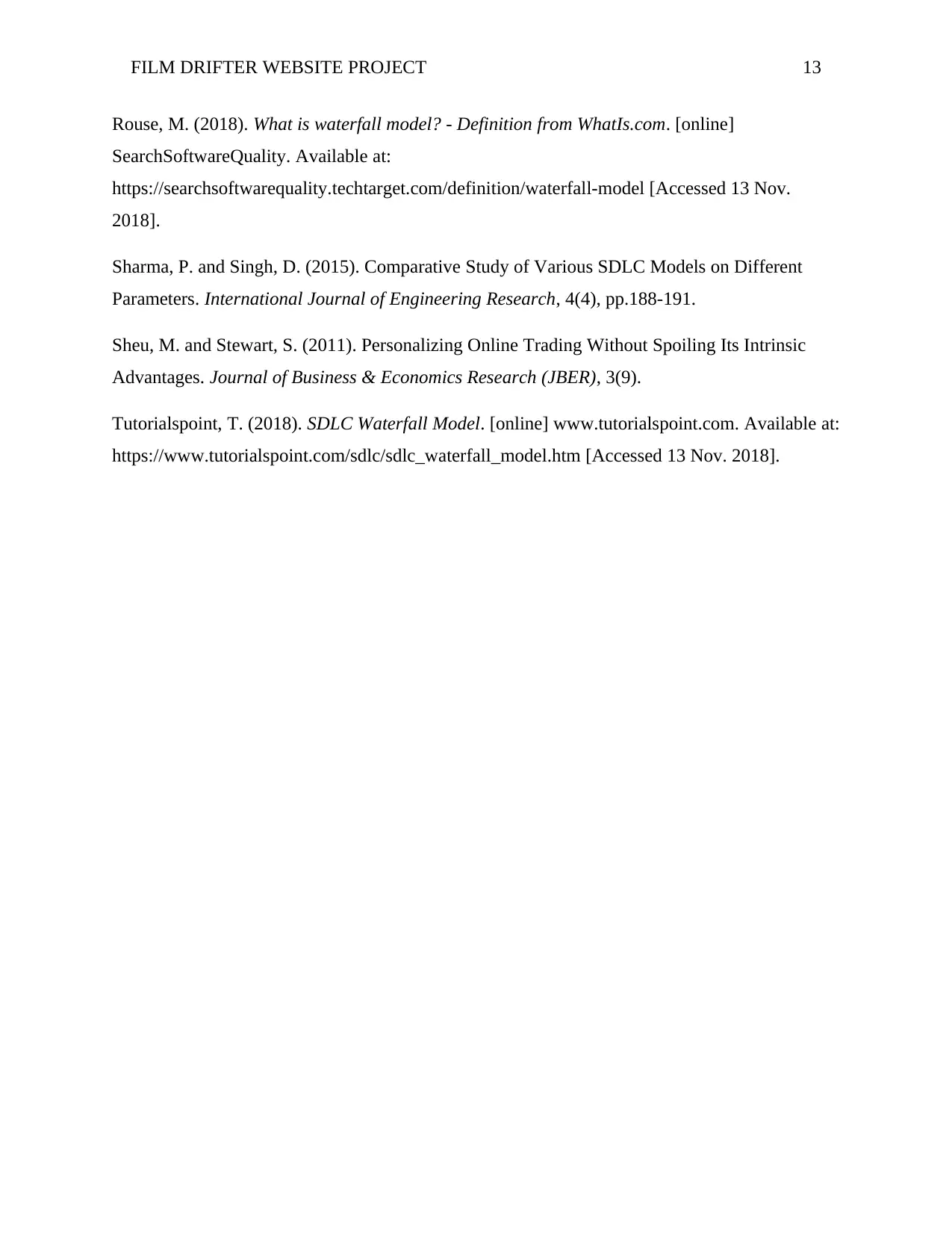
FILM DRIFTER WEBSITE PROJECT 13
Rouse, M. (2018). What is waterfall model? - Definition from WhatIs.com. [online]
SearchSoftwareQuality. Available at:
https://searchsoftwarequality.techtarget.com/definition/waterfall-model [Accessed 13 Nov.
2018].
Sharma, P. and Singh, D. (2015). Comparative Study of Various SDLC Models on Different
Parameters. International Journal of Engineering Research, 4(4), pp.188-191.
Sheu, M. and Stewart, S. (2011). Personalizing Online Trading Without Spoiling Its Intrinsic
Advantages. Journal of Business & Economics Research (JBER), 3(9).
Tutorialspoint, T. (2018). SDLC Waterfall Model. [online] www.tutorialspoint.com. Available at:
https://www.tutorialspoint.com/sdlc/sdlc_waterfall_model.htm [Accessed 13 Nov. 2018].
Rouse, M. (2018). What is waterfall model? - Definition from WhatIs.com. [online]
SearchSoftwareQuality. Available at:
https://searchsoftwarequality.techtarget.com/definition/waterfall-model [Accessed 13 Nov.
2018].
Sharma, P. and Singh, D. (2015). Comparative Study of Various SDLC Models on Different
Parameters. International Journal of Engineering Research, 4(4), pp.188-191.
Sheu, M. and Stewart, S. (2011). Personalizing Online Trading Without Spoiling Its Intrinsic
Advantages. Journal of Business & Economics Research (JBER), 3(9).
Tutorialspoint, T. (2018). SDLC Waterfall Model. [online] www.tutorialspoint.com. Available at:
https://www.tutorialspoint.com/sdlc/sdlc_waterfall_model.htm [Accessed 13 Nov. 2018].
1 out of 13
Related Documents
Your All-in-One AI-Powered Toolkit for Academic Success.
+13062052269
info@desklib.com
Available 24*7 on WhatsApp / Email
![[object Object]](/_next/static/media/star-bottom.7253800d.svg)
Unlock your academic potential
© 2024 | Zucol Services PVT LTD | All rights reserved.





